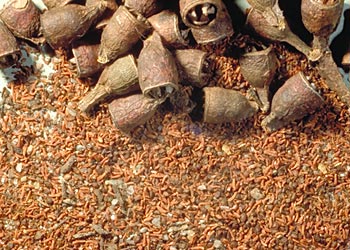
When to Plant Eucalyptus Seed
Lindsay J. Daniels
As with most aspects of growing native plants, there are many ideas, sometimes conflicting, on when eucalyptus seed should be sown. I have tried sowings at different times throughout the year and have also obtained the opinions of other growers of native plants. The following article is based on my experiences and findings and that of others.
In most areas of Queensland seed of most species of eucalypts can be sown and reasonable germination can be obtained at any time of the year without using artificial heat. To do this, a sheltered position that is warmed by the sun is necessary. This is usually on the northern side of a building. Natural light and ventilation should be good, but it should be protected from heavy rain. In winter the areas may receive some direct sunlight particularly in the morning, but in summer it should not be in direct sunlight.
Although germination will occur right throughout the year, germination is usually slower, more uneven and percentage not as high during the period from May to mid-August. During this period germination may take from 2 to 3 weeks, compared to 3 to 10 days during spring and summer. I have also found that, while fresh seed that has a high viability will germinate satisfactorily during the winter period, older seed often gives a much poorer result, even though this older seed may give reasonable germination in the warmer months.
| |
 |
| |
Seeds (and chaff) of the river red gum
(Eucalyptus camaldulensis) |
As a general rule the best time for sowing eucalyptus seed appears to be early spring. I have had consistently good results by sowing during the first warm spell. The time of this will vary from year to year and from district to district, but in most areas of central and southern Queensland it can be from late August to mid-September. This is the time when most plants will commence to make new growth. Although, temperatures during this period will not be as high as later in the summer, plants appear to want to grow and reproduce as soon as temperatures start to warm up.
Sowings can continue right throughout the summer with the prospect of good germination, but seedlings from sowing during the hottest period often have to contend with more pest and disease problems. The late summer to autumn period, during March and April, usually gives good germination and, although later growth is slower, pest and disease incidence is generally low, and for some species and in our hotter areas, autumn sowings may have some advantages.
An exception to the early spring plantings are some tropical species of eucalypts. These give best germination if sowing is delayed until October or November when temperatures are higher, as they apparently need a higher optimum temperature for germination. Winter sowings of these species are not recommended.
Although reasonable germination can be expected from seed of most species of eucalypts in most areas of Queensland throughout the year, the optimum time for sowing appears to be spring and early summer, with the autumn period being the next most suitable time. My experience of the germination of species other than eucalypts indicates that generally they follow the same pattern as that for eucalypts; so that the best times for planting eucalyptus seed also appears to be the best times for planting seed of most species of native plants.
The spring and early summer sowings have the added advantage in that the resultant plants will be of suitable size for planting out in the ground in the following March - April period. This time appears to be the best time for planting out of most species in most areas of Queensland.
From the newsletter of the Pine Rivers Branch of the Society for Growing Australian Plants (Queensland), September 2007.
Australian Plants online - 2007
Association of Societies for Growing Australian Plants
|